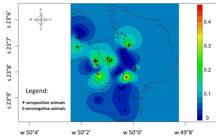Abstract
Brazilian spotted fever (BSF) is a fatal zoonosis because of the difficulties in its early diagnosis and treatment. Occurrences of BSF in the northeast of the state of Paraná prompted investigation of areas at risk of this rickettsiosis in the municipalities of Japira, Jaboti, Pinhalão and Tomazina. To determine the areas at risk, 592 serum samples from dogs and 230 from equids were analyzed by means of the indirect immunofluorescence assay (IFA) for Rickettsia rickettsii and R. parkeri . In addition, risk probability maps were drawn up using the kriging indicator technique. Among the samples tested, 5.3% (43/822) indicated presence of antibodies reactive to at least one of the two Rickettsia species tested: 7.8% of the equids (18/230) and 4.2% of the dogs (25/592) were positive. Geostatistical analysis showed that the average seropositivity rate was 5 to 6%. Although the average seropositivity rates observed among these dogs and equids were lower than those reported from endemic areas of Brazil, the biotic components (etiological agent, vector and reservoirs) and environmental aspects of BSF epidemiology were present in these municipalities.
Keywords:
Rickettsia rickettsii; Rickettsia parkeri; risk map; serology; geostatistical analysis

 Thumbnail
Thumbnail
 Thumbnail
Thumbnail
 Thumbnail
Thumbnail
 Thumbnail
Thumbnail



